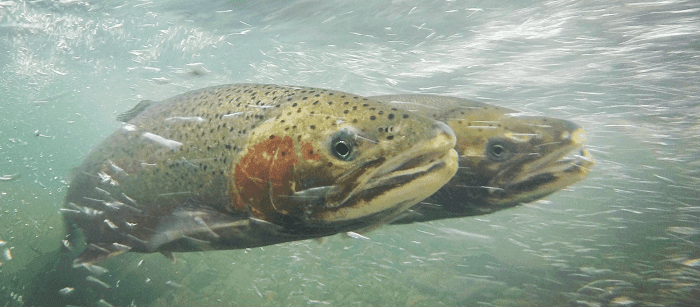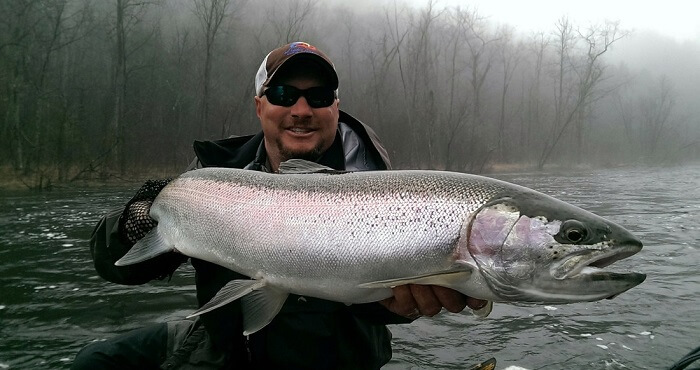We all know how vast fly fishing is. The sheer number of people and the ways to fly fish really boggles our mind. It is natural to assume that the ways to fly fish different kinds of fishes are also very much varied. In this article, we’re going to discuss how to fly fish for steelhead fishes. But before getting into the actual way to catch such fishes, we’re first going to go over the information about steelhead. Let us get into it then.
Where To Find Steelhead Fishes?
Steelhead, also known as, Steelhead trout is a sea-run form of a coastal rainbow trout. These freshwater steelhead fishes can weigh in average from 1 to 5 pounds while the fishes on lakes and sea-run fishes can reach up to 20 pounds. The color of the fish mainly depends on where you find it. They can be spotted with a broad reddish stripe along the lateral line. This is clearly visible with the males, females are a bit harder to spot.
As far as the location goes, steelhead fishes are native to the Pacific ocean and to North America as well as the Asan rivers. Truth be told, you can find a steelhead fish in every continent except for well, maybe Antarctica. Speaking of the exact location, Columbia River is considered to the best place to find a steelhead fish.
Steelhead fishes are naturally found in saltwater or they are lake dwelling, they can also be found in fresh water. The freshwater steelhead fishes are generally bluish or olive colored whereas the anadromous ones have silver color with no red stripes.
Steelhead Fly Fishing Gears & Techniques
As far as the technique goes, it can largely vary. To catch a steelhead using flies, you need to cover a lot of water. Endurance will be your friend here. Angling a steelhead cannot be done casually. You also need good gear for it, more on that later.
Exert less force and minimize the fatigue. If your casting skills are on par, you spend less energy and thus get more. As we all know, fishing is an art and casting requires a whole lot of practice. Make sure you have the necessary skillset initially.
The gear, on the other hand, is also an important factor. You can have all the skill in the world but if you don’t have proper gears, you won’t be successful. Here, we’re going to go over all the things that you’d need for fishing steelhead fishes from rods to reels and lines.
Rods
For safety fishing a steelhead, a rod which has less weight but is very powerful is needed. Which kind of rod you need will depend on the place where you are fishing from. Fishing from a boat and fishing without one is completely different.
If you’re trying to fish in small coastal rivers and creeks then go for a single hand rod because it wades deeper. 9 to 10-foot rods are very popular to fish from boats.
As far as local rivers go, they have untidy banks. This is where roll casting takes its advantage so two-handed fly rods of length up to 15 feet can give you the most advantage here.
Reels
Reels become crucial when you see a steelhead. Your reels might have to feed and cover a long distance of the line and baking. The drag system should be precise, waterproof drags are recommended. The drag pressure should be around 3 to 4 pounds. Your reel should also be working to its full potential. It determines your success rate when you see yourself against a, particularly large fish. The reels should hold a fly line with 150 yards of backing. The ball bearings should be sealed as well. Drag system? Go for disk drags. Opt for machine frames because of their strength. The reel should have an anodized coating. Make sure the reel has few moving and total parts.
Fly Line
For a single-handed rod, a floating fly line is recommended if your goal is to nymph fish while out of a boat. When you’re using a two-handed fly rod, it is recommended that you use spey lines.
Leaders and Tippets
As far as the leaders go, the length should be 10 to 15 inches for two hand rods and 9 inches long for a single hand rod. The tippet diameter of the leader should be around .011 as this gives the most advantage in a lot of situations. If you want to include a dropper too, use a tag end of 12 or 15 pounds test sections. For your sinking tip lines, the leaders should be 4 to 6 inches long. Tippets with smaller diameters will not provide the freedom to the fly to move around in some currents.
How To Fly Fish For Steelhead
There are two main tactics for fishing steelhead. These two techniques are explained below:
Nymphing Technique
Nymphing requires you to have some gear beforehand. The whole process with the gear requirements are given below:
- You need a 9 or 10-foot single-hand rod will work the best for nymphing. The rod should be of 8 weight. You need a weight-forward line for a single hand rod. As far as a switch rod is concerned, you can use the Skagit line. The leader that you’re about to use must be twice as long as the depth of the water. These are the requirements that you MUST have.
- Setting up the nymphing is next. This is pretty simple too. For simplicity, use an indicator above your fly with a split shot. This should be placed 18 inches above the location of your fly.
- The best pattern is the “Go bug” pattern but you can use stoneflies and other different patterns and bugs.
- The goal of the nymphing method is to get a dead drift i.e, a natural float downstream with the water’s speed.
- As your line moves downstream, extend your run by feeding the slack. When your line has straightened out below you, get up for another cast up into the slot.
- The next thing you’d want to do is to look out for any seam lines in our chase. The steelhead fish will generally be held on the edge of the faster water. They are also readily available in the areas where they can break things.

Swinging Technique
Swinging is another technique for steelhead fishing and it is probably one of the easiest methods. It is certainly easier than nymphing.
The steps can be summarized as below:
- Cast the fly
- Give it a small mend
- Keep the tip of your rod near the water
- Patience is the key, wait for a pull
This may sound simple but there are many things here. We’ll get into the details now.
First of all, you need to look out for broken water because steelhead like that type of water and they take shelter in these places. The obstructions, so to say, aren’t very obvious initially.
You should also be careful about the gear. You need a 12 or a 13-foot Spey rod for Skagit or Scandi Spey lines. Single hand tods? 9-foot length with 8 weight is the requirement. In addition, Using a sinking line will require a shorter leader. That’s it for the requirements, nothing too fancy here.
You should concentrate on covering the water to actually find the fish. Catching it will be pretty easy once you have the fish.
Tips To Do Better In Fly Fishing Steelhead
Experience always comes into play. Even if you follow a guideline there is always something to learn from someone who is a pro in the field. We can’t give you that experience on a plate but we can give you so much needed tips that are going to make your fishing experience much easy:
- Patterns of flies that work for steelhead fishing: Egg-Sucking Leech, Glo Bug, Max Canyon, Purple Burlesque, and Kaufmann’s Stone
- Fish when there is enough light to actually see the fish
- Remember the formula; Skagit line for Spey rods: Heavy flies, deep water and Scandi line for lighter flies, shallow water
- Maybe read a book or two about steelhead fishing? Do this only if you’re a total fish nerd!
- Use a fresh, sharpened hook perhaps. You can let your fly hand at the end of the swing too
- Practice! Practice!! More practice!!! Your casting should be perfect
- Mark the hooking spot, it will be helpful the next time you go fishing
- Switch positions until you get an angle that works, elevated positions could work
- Switch the fly’s depth too, it can work sometimes
- The perfect water to fish is 3 to 6 feet deep and is flowing at a walking speed
- If you’re a newbie, follow every guideline without any hesitation
Conclusion
Well, steelhead fly fishing can be a daunting task. It isn’t something impossible though. Anyone with a proper experience and a little skillset can pull it off. You just need to follow some guidelines and make sure you get proper gear. Skill is still vital. Having only the gear won’t do any good. In conclusion, we hope this article contributes to your steelhead fishing experience. Happy fishing to you!
Last update on 2024-03-31 / Affiliate links / Images from Amazon Product Advertising API
